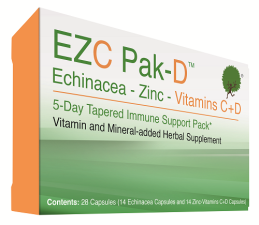The Impact of Natural on the OTC Category 3/16/2018
The two ECRM/Drug Store News Buyers Choice award winners from ECRM’s recent Cough/Cold, Analgesics & Allergy EPPS were indicative of the OTC category’s trend toward natural products.
PPC Group’s EZC-Pak-D, which took first place, is a natural, physician-formulated immune support pack developed to reduce the overuse of antibiotics during cold and flu season. It’s made with certified organic Echinacea purpurea, zinc, and Vitamin C, and is vegetarian, gluten-free and has no added sugar. Finalist Unipharma, LLC’s DrKIDS HIMASAL Babies are hygienic and natural saline drops specially made with Himalayan Salt to moisturize and soothe a baby’s airways.
Indeed, the consumer trend toward natural OTC products like these was the topic of the educational session by Hamacher Resource Group VP of Strategic Relations Dave Wendland, who discussed the challenges and opportunities of working natural products into the OTC category. (Click here to download the slide presentation)
According to Wendland, natural is a complex issue, as there are limited standards for natural products, and the definition of natural varies by consumer. On top of this, many natural products deliver an inconsistent experience. “The term, ‘natural’ is entirely unregulated by the government,” said Wendland. “Since the FDA hasn’t yet issued an official definition of natural, consumers have different understandings of what the term means.”
For the purpose of the discussion, Wendland definined natural OTC products as self-care products that consumers use to prevent or treat minor ailments. These products are:
- Drug free
- May contain plant- or herb-based ingredients
- Vitamins and supplements
- Homeopathic (in most cases)
Because of this, retailers and brands are still working through strategies on how to work natural OTC products into their assortments, such as integrating or segregating the natural product mix, both of which have pros and cons. For example, integrating natural and conventional products gives shoppers the opportunity to compare them side by side. However, if these shoppers rarely purchase natural, an integrated set may be confusing. Those who do purchase natural, on the other hand, will have to hunt and peck for these products from within the conventional items. Segregated integration -- in which natural products are separated and highlighted within the set -- may provide the best of both worlds, enabling shoppers to easily view natural options within the entire assortment.
Following are some recommendations and actions steps Wendland outlined for retailers and brands looking to integrate natural into their OTC assortments:
Actions steps for retailers
- Take advantage of fast growth across children’s relief products, personal care, preventive care, pet products, and combination solutions
- Cross-merchandise natural products, especially during cold and allergy seasons, at the checkout, in vitamins/minerals, or near the pharmacy
- Add homeopathic, natural, and organic cough and cold remedies to the mix
- Stock a broader (and correct) assortment of natural and organic options
- Improve in-store navigation, signage, and access to expertise in the aisle
- Consider ancillary services you could provide your shoppers (e.g., nutritional guidance, personalized solutions, etc.)
Actions steps for brands
- Don’t forget your packaging – sustainability, clean labeling, and convenience matters
- Take the time to get the message right – you have less than 5 seconds to convey the product’s key attributes
- Use blogs, social media, online media and key publications aimed at mothers and other consumers
- Get your online assets in order (digital images, descriptions, and SEO-friendly content)
- Ensure compliance with labeling and claim guidelines
- Clearly communicate the benefit of your item(s)
- Create excitement with ingredient choices, flavors and forms, and convenient delivery options
- Tell the story of your brand (could have listed this as the first step … it is a high priority!)
- Understand the depth of knowledge of your target shopper – and connect where it matters most
- Know the values your customers appreciate and what they are looking for from your brand
- Elevate your role in their health journey through resources, tools, and education


Tony can be reached at (440) 528-0416